Darrell Brooks trial: Prosecutors focus on arrest after parade attack
Darrell Brooks trial: Police, neighbors recount defendant's arrest
They saw something suspicious and said something. That's how police tracked Darrell Brooks to a Waukesha neighborhood after prosecutors say he drove through the Christmas parade, killing six and injuring dozens more. The jury in his murder trial learned more about his arrest during testimony Monday.
WAUKESHA, Wis. - Witness testimony resumed Monday morning, Oct. 17 in the Darrell Brooks trial, charged in the November 2021 Waukesha Christmas parade attack. The state hoped to wrap up its case Monday, however, due to interruptions from Brooks, there was more testimony.
On Monday, prosecutors focused on Brooks' arrest after the Christmas parade attack, calling nine witnesses.
Juror calls in
Judge Jennifer Dorow said a juror called in Monday morning not feeling well, and that juror was excused, impacting the selection of alternates.
There was also a discussion about the state's "victim map," and that exhibit was fully received by the court and admitted into evidence despite Brooks' objection.
The state said they placed it on his table with his other materials.
Judge Dorow said it was one of the papers Brooks left in the "bullpen area" and said she actually made a record of providing it back to him, so he had it twice.
Plea offer read to Brooks
Waukesha County District Attorney Sue Opper indicated a pre-trial offer was made to Brooks. Brooks indicated he did not have this pre-trial offer.

Darrell Brooks
"It was provided to you. You are indicating you haven’t read it. If, at any time, you want to change your plea, you can," said Judge Jennifer Dorow.
The district attorney, for the record, then read the pre-trial offer, but Brooks stated, "It's not something that was conveyed to me."
The offer would include Brooks pleading guilty to Counts 1-67. Counts 68-83 would be dismissed and read into the court record. He would receive six life sentences for Counts 1-6 and unspecified prison terms on the other counts.
Prosecutors said this was given to Brooks' former attorneys in July 2021 and again in January 2022.
Subject matter jurisdiction, again
Before the jury was brought in, Brooks, as he has before, brought up subject matter jurisdiction.
Judge Dorow noted she issued a written ruling on this matter during Week 2 of the trial.
"If you disagree with that, you can take that up to a higher court," the judge said. "My written decision is the decision of the court. Your position is simply not correct as a matter of law."
The judge added that, "you might be confusing subject matter jurisdiction with venue."
Brooks demanded "verified proof of subject matter."
Sean Backler, accused Brooks of ‘trespassing’ in his yard
The first state witness to take the stand on Monday was Sean Backler, who indicated he was working in his yard on the day of the Waukesha Christmas Parade. Backler testified he saw Brooks at the side of his house.
"He was trespassing," said Backler.
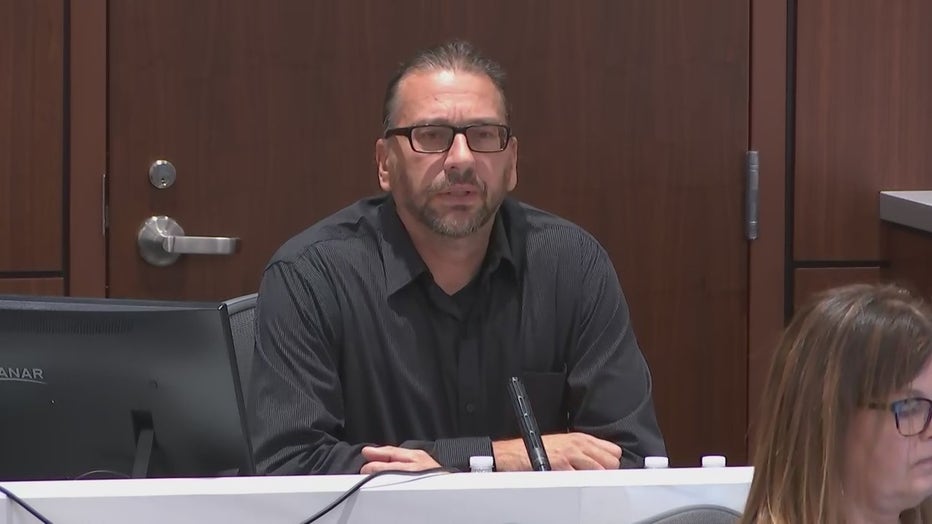
Sean Backler
Backler talked about his brief contact with Brooks. He stated he asked Brooks what he was doing there and then offered a description of Brooks; later identifying Brooks in the court as the same person. Backler testified something seemed "off" with Brooks.
"He was wearing a T-shirt. No shoes. Sweating. His eyes were huge. He was just acting -- when he came out from the garage, he asked if I could call him an Uber," Backler said.
Backler said he did not call an Uber for Brooks.
"I said he needed to leave," said Backler.
On cross, Backler said he called the non-emergency line to report this encounter.
"I said the individual was either black, mixed or Latino," said Backler.
Backler added, "I was positive it was you."
"Who's you?" Brooks asked.
"You. I’m looking at you," said Backler.
"Would it be fair to say I’m not 5'9' and 160 pounds?" Brooks asked, referring to Backler's earlier testimony.
Brooks asked whether he followed the investigation.
"It’s kind of hard not to," said Backler. "I went to work the next morning, got the police report and mugshot. I said, 'That’s the guy.'"
"All I can say is you were trespassing," Backler added. "You were the guy in my yard. I was curious if you were the person and the one who did the atrocities at the parade."
Brooks asked whether he gave a written statement to the police, and Backler said "no."
"Any reason why not?" asked Brooks. "You said you pulled up the police report the next day."
"I pulled up your mug shot," said Backler "I wanted to see if the person in my yard was the person who committed those atrocities, and it was."
Brooks then went into his usual line of questioning about who subpoenaed him, who he spoke with in regard to this investigation and who the plaintiff is. Judge Dorow ended this line of questioning.
Domanic Caproon, saw Brooks in his driveway
Next to testify for the state was Domanic Caproon. Caproon said Brooks came up his driveway, lifted his shirt and said he did not have any weapons and needed a phone to call an Uber. Caproon stated he handed him a phone.
Caproon positively identified Brooks as the man he met in his driveway. He testified he remembered a tattoo above Brooks' eye.
"He wasn’t wearing a jacket or shoes," said Caproon. "He was wearing blue jeans and a red T-shirt."
Caproon later indicated he provided police with his phone so investigators could see who Brooks called on that date.
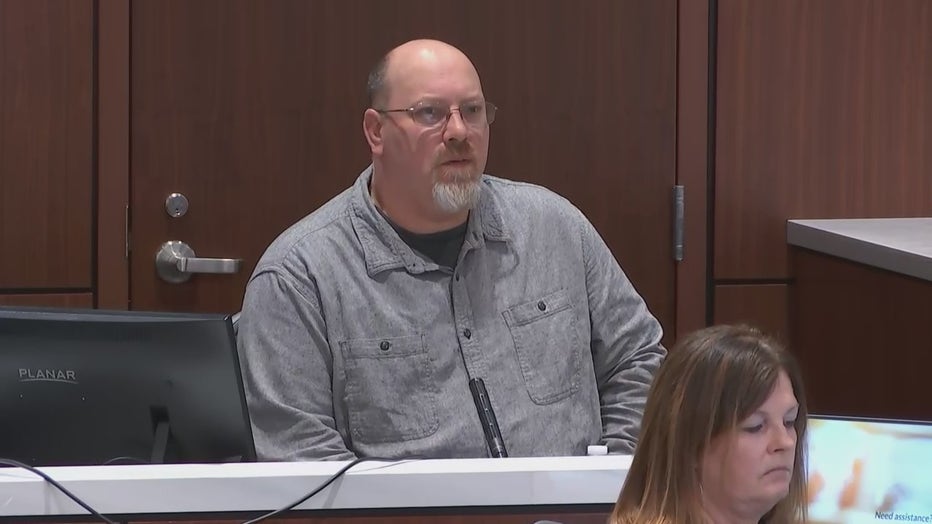
Domanic Caproon, lives on Central Ave; was in driveway and saw Brooks
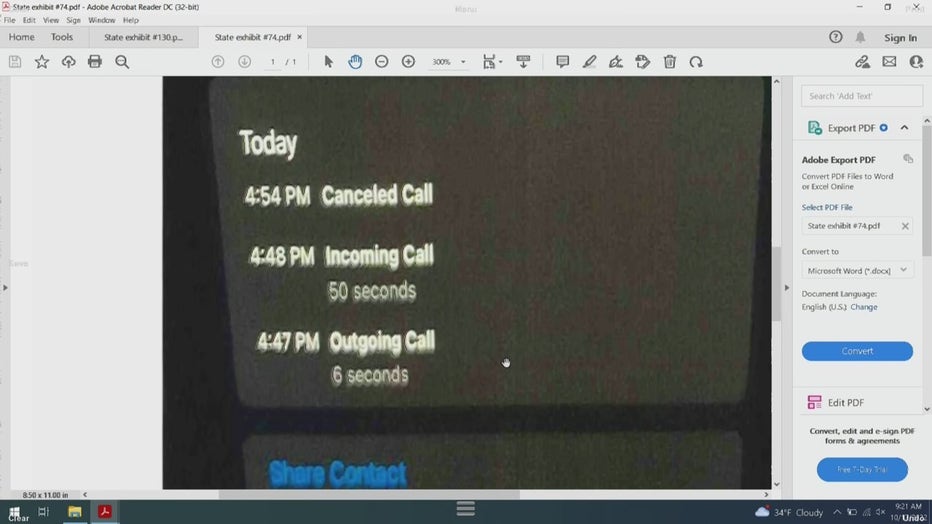
Domanic Caproon's phone used to make a call by Darrell Brooks after parade attack
"He called somebody, which, at the time, I thought was Uber," said Caproon. "A lady called me. I asked if she was an Uber. She said, ‘Is she an Uber?’"
He said Brooks eventually left.
On cross, Brooks asked Caproon whether it was dark or dusk and whether he would be unable to identify tattoos. Caproon said he "could make them out." Brooks noted that in his police report, he said he wasn't able to.
Brooks also questioned Caproon as to the callback that he received.
"Did you ask who it was?" asked Brooks.
"I just asked if it was an Uber driver," said Caproon.
Erin Cordes, attended Waukesha Christmas Parade
The state next called Erin Cordes to the witness stand. Cordes indicated she watched the Waukesha Christmas Parade from West and Wisconsin, which was near the end of the parade route, and saw a police officer fire "three shots at the vehicle."
"Our kids were in the middle of the road picking up candy at that time," said Cordes.
"We stayed by the house in shock for a little bit," Cordes added, unsure at that time what was happening.
She said they parked on Elizabeth Street near Aries Industries. That's where she and her family ran into Darrell Books when he came out of the bushes. She positively identified Brooks in court after he removed his mask.
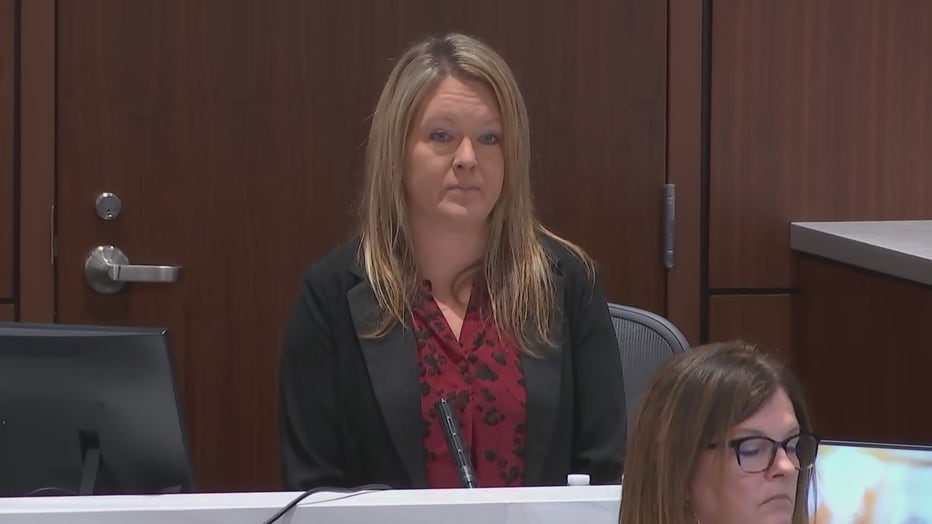
Erin Cordes
"It appeared he came from out behind two houses," Cordes said. "It was a windy, cold night. He was shivering, had a red shirt on and no shoes."
Cordes testified Brooks asked if she or her husband had a phone he could use.
"We were both pretty much on edge at that point after the parade," Cordes said of herself and her husband.
Cordes said Brooks told them, "I’m not going to hurt you. I just need to use your phone."
After getting the phone, Cordes stated Brooks appeared to be calling his mother to call him an Uber.
"There was a sense of urgency, and he needed it now," Cordes said.

Darrell Brooks at Aries Industries Inc after coming in contact with Erin Cordes
Cordes also testified Brooks was cold and asked her and her husband where there was a place he could warm up.
Video was shown of Brooks walking up to the doors of Aires Industries before turning away.
On cross, Brooks asked Cordes if she could see into the red SUV or if the shots that were fired hit the vehicle. She said she could not see into the SUV, and she said she was running toward a house right after the shots were fired, so she didn't see whether the vehicle was hit.
After Cordes' testimony, the court took its mid-morning break.
Anthony Winters, Lyft driver
Before the next witness took the stand, Brooks and Dorow sparred over subject matter jurisdiction again.
Anthony Winters, a Lyft driver, testified next for the state. Winters testified he was called for a ride at a company that was closed.
"The fare came in from Dawn," said Winters. Dawn is Brooks' mother's first name. "I was told I was looking for a Black guy with dreadlocks."
When Winters arrived at the pickup location, he said the parking lot was empty. There was no one there.
"I received a message back," said Winters. "They were calling a ride for someone else. They didn’t know who he was."
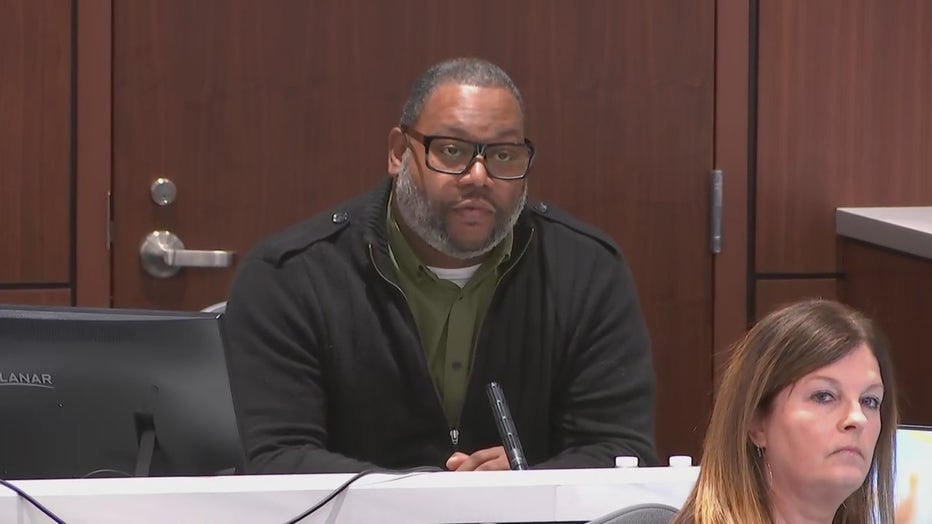
Anthony Winters, Lyft driver
"I got out of the car, knocked on the door, sent a message saying there was no one around," Winters testified.
Winters said he waited more than seven minutes. Nobody showed up, and he then canceled the ride.
Daniel Rider, Brooks showed up at his doorstep
Daniel Rider, the state's next witness, testified Brooks showed up on his doorstep in Waukesha.
"There was a man who rang my Ring doorbell, said he was homeless and cold and needed my phone," Rider said.
Rider said it was unusual because it was cold that November day and Brooks had on a T-shirt and no shoes.
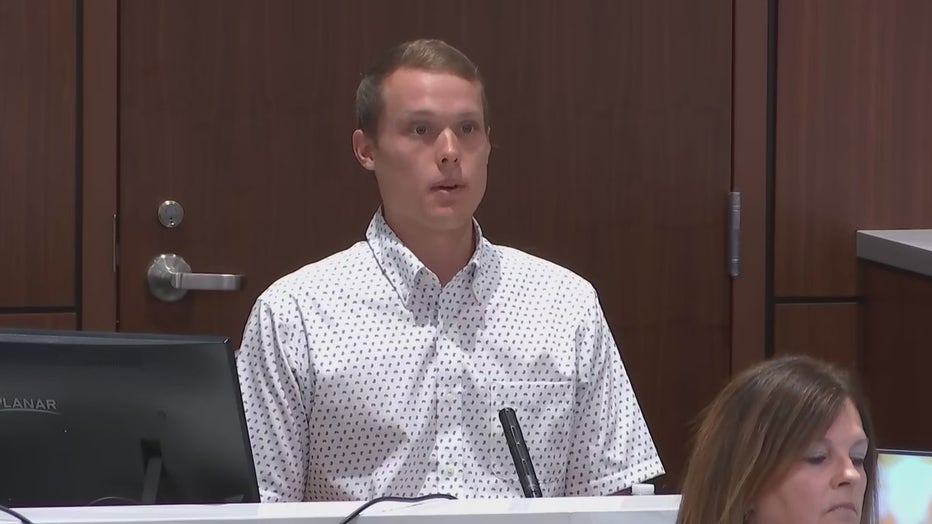
Daniel Rider
"I didn’t get the verbal interaction with him on camera because it only records 20 seconds," Rider said.
Rider then described what was captured by his Ring doorbell and that there were four clips submitted to police of Brooks going up to his door. Those clips were played in court, and Rider was given an opportunity to describe what was seen in that video.
"He was on my porch for about a minute," said Rider. "He said he didn’t have any weapons. I let him inside. He could come and warm up."
Rider testified Brooks was "on the phone with his mom."
"He lifted his shirt, and I was like, ‘Oh, don’t worry. I’m not going to pat you down or anything.’"
Rider said he asked him to go into the back door because he just got back from hunting. He said he gave Brooks a coat and a phone, and he stayed for around 10 minutes.
"I gave him a sandwich and offered slippers," said Rider. "I heard him say ‘mama’ a lot, and she called my phone back after and left a message."
That voicemail was played in court.
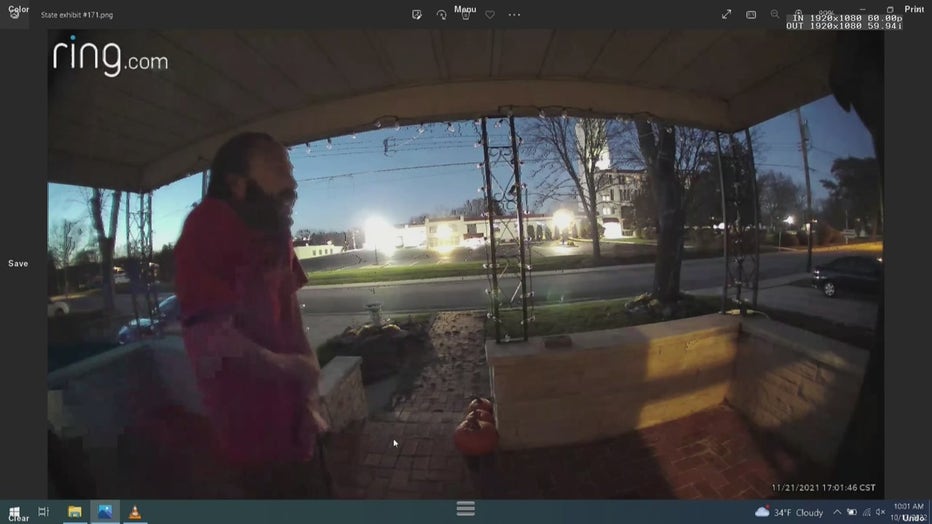
Darrell Brooks at Daniel Rider's home
Rider described Brooks' demeanor as "flustered, but he was grateful and thankful -- ‘thanks for showing me, love man.’"
He said after Brooks left, he came back in because he forgot his ID.
"The suspect came back a minute later, asking to come back inside and that he left his ID. I went back in to look for it but didn’t let him back inside. There was nothing left in my house," said RIder.
On cross, Brooks asked Rider about the fact that the footage was on social media.
"I released it," said Rider. "The news wanted the footage. I thought this was good footage for this community to see the suspect in cuffs, so I released it."
He said he was paid for the footage.
"We were getting bombarded with media requests, and we worked with an agent and I don’t know what we got on the back end," he said.
He said he didn't feel like he was in any danger "until I saw the police come."
"The person at my door was very polite," said Rider. "I didn’t feel in danger. I don’t think he ever asked for a jacket and sandwich. I offered them to him."
Rider said he learned the name of the suspect and details of the parade attack shortly after this encounter. He noted that a lot of his neighbors were at the parade.
"Neighbors called after I was done, and I explained the suspect was arrested at my front porch," said Rider. "Craig, my next-door neighbor, said he saw the red SUV running over people."
Rebecca Carpenter, Village of Big Bend Police Department, detained Brooks
After a lunch break, the state proceeded with its case by calling Officer Rebecca Carpenter to the stand. She works for the Village of Big Bend Police Department.
"I heard a broadcast there had been shots fired," said Carpenter. "Squads on my channel…started to say they were placing injured people and taking them to the hospital."
She said she then started driving toward downtown Waukesha.
From there, Carpenter responded to Elizabeth Street after hearing there was a man going door-to-door asking for people's phones to call an Uber. She said she and other officers started looking for this person.
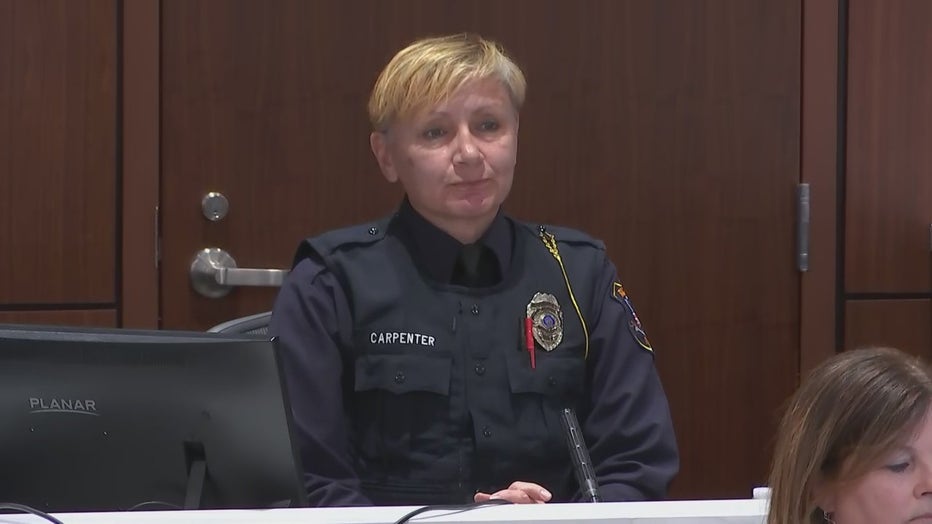
Rebecca Carpenter, Village of Big Bend Police Department
Officer Carpenter told the court that during her encounter with Brooks on Elizabeth Street, he identified himself as Darrell Brooks. She first saw him on Daniel Rider's porch.
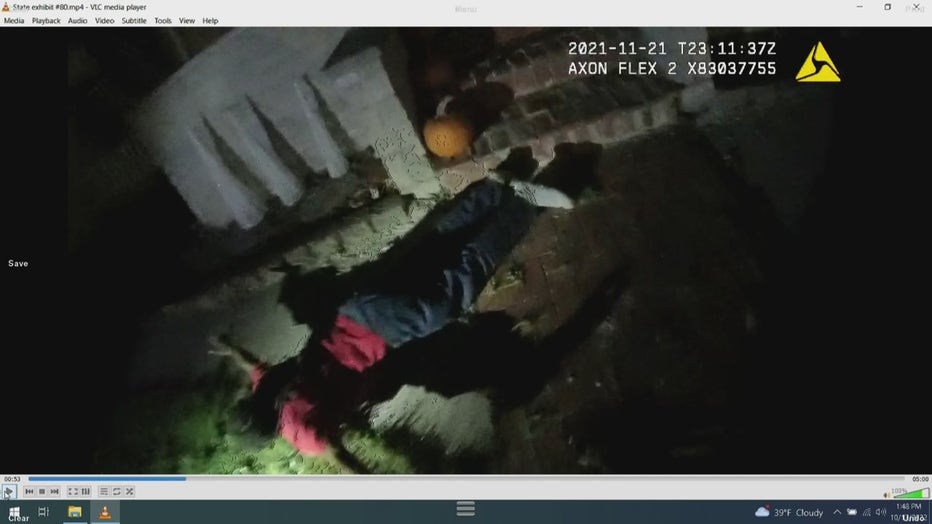
Darrell Brooks during his interaction with Rebecca Carpenter
"I first saw him standing on the porch," said Carpenter. "He appeared to be rather agitated."
Carpenter said it was cold that night. Brooks was in a T-shirt and no shoes. Carpenter said she asked the man to identify himself by name. He said his name was "Darrell Brooks."
"I was coming from the parade route. I have a friend over there. Did I do something?" Brooks asked Carpenter in the body camera video.
In the body camera video, Brooks is heard asking Carpenter, 'Can I please just sit up?" He told a second officer his name was "Darrell Brooks." Carpenter asked, "Where are your shoes?" Brooks said his flip-flops were in Rider’s house. No shoes were inside.
Carpenter said she took an ID, a credit card and a car key from Brooks. Carpenter said she found a sandwich in Brooks’ pocket. Rider made Brooks a sandwich after knocking on his door, telling Rider he was homeless.
No weapons were found during a search of Brooks, who was taken to a squad car because he "was not dressed for the weather."

Darrell Brooks at Daniel Rider's home
Carpenter testified Brooks was wearing "jogging pants." On cross, Brooks questioned Carpenter about whether the pants the suspect was wearing in the body camera video were really blue jeans.
He also asked about the police report.
"Do you recall writing the subject was being detained for investigative purposes…" asked Brooks.
"At the time, I was not fully aware of the circumstances," said Carpenter.
She said she "knew people had been hurt" and she knew shots were fired, but she didn't know the "magnitude."
"Just that something violent had happened," she said.
Darrell Brooks trial: Big Bend officer testifies about the arrest of Brooks
Officer Rebecca Carpenter told the court that during her encounter with Brooks on Elizabeth Street, he identified himself as Darrell Brooks. In the body camera video, Brooks is heard asking Carpenter, 'Can I please just sit up?" He told a second officer his name was "Darrell Brooks."
Brooks asked if she gave him a reason as to why he was being detained. She said he was informed he was being detained for investigative purposes -- "an answer that's appropriate for the circumstances."
"I did not have a lot of information to give you, sir," said Carpenter.
"You keep saying 'you,'" said Brooks. "Who is the 'you' that you keep referring to?"
"You, Darrell Brooks. The defendant. Seated at the defense table," said Carpenter.
Brooks also asked about why she was called to the area, and she said it was for "suspicious behavior." She said she had her gun drawn because she knew that shots were fired.
"I did not know by whom," she said. "I did not know who had done shooting."
"Any reason to believe that the shots came from the suspect?" asked Brooks.
"I did not know," said Carpenter.
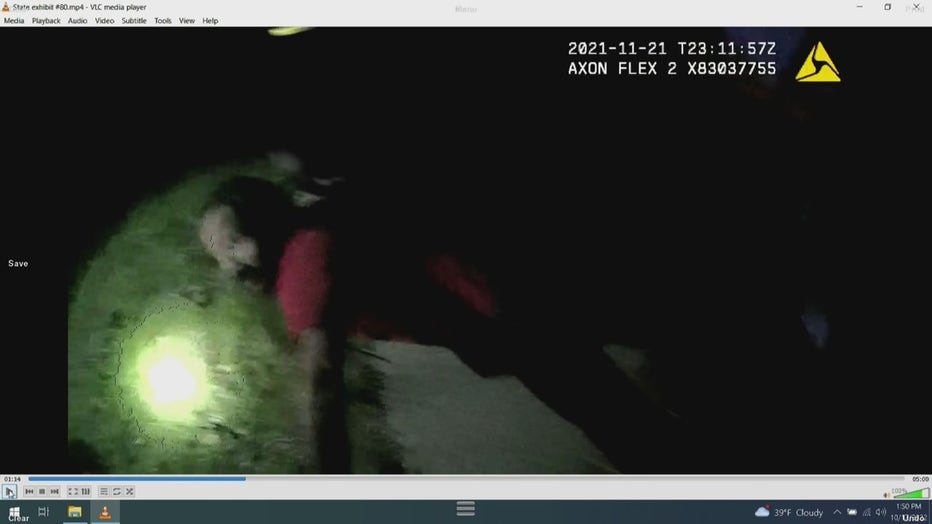
Rebecca Carpenter's body camera video
She noted that the shots fired incident happened "in the general area of the parade," and Brooks asked whether the area she was searching on Elizabeth street was in the "general area of the parade." She noted it's a few blocks away.
Brooks asked about why Carpenter stayed at the scene for "hours."
"When there is a crime scene that potentially spans blocks, everything needs to be searched for evidence. Witnesses need to be located. Once things are gone, they are gone," she said.
Brooks asked about the body camera video in which "the suspect gave you his name."
"That's correct," said Carpenter.
On re-direct, Assistant District Attorney Zachary Wittchow asked how Brooks ended up on the ground.
"We instructed him to put his hands up and then to get down on the ground," she said.
Carpenter was asked if they threw him to the ground.
"We did not," she said.
Garrett Luling, Waukesha police officer, responded to Brooks' detention
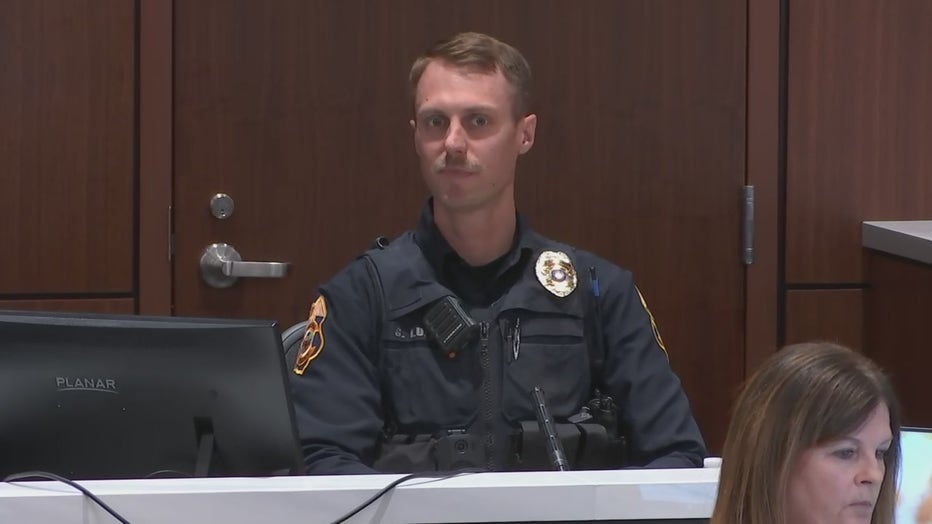
Garrett Luling
Next up for the state was Garrett Luling, a Waukesha police officer, who said he heard a subject was going door-to-door.
He said he saw three officers detaining a subject on the front lawn of a home at gunpoint at 550 Elizabeth Street.
Luling identified that subject as "Darrell Brooks." He identified "Darrell Brooks" as the defendant.
He said he did not see Brooks slammed to the ground or any use of force toward Brooks.
Opper asked Luling if there was any significance to that name. Luling said he knew Officer Moss, who previously testified, had checked the red SUV, finding documentation belonging to a Darrell Brooks.
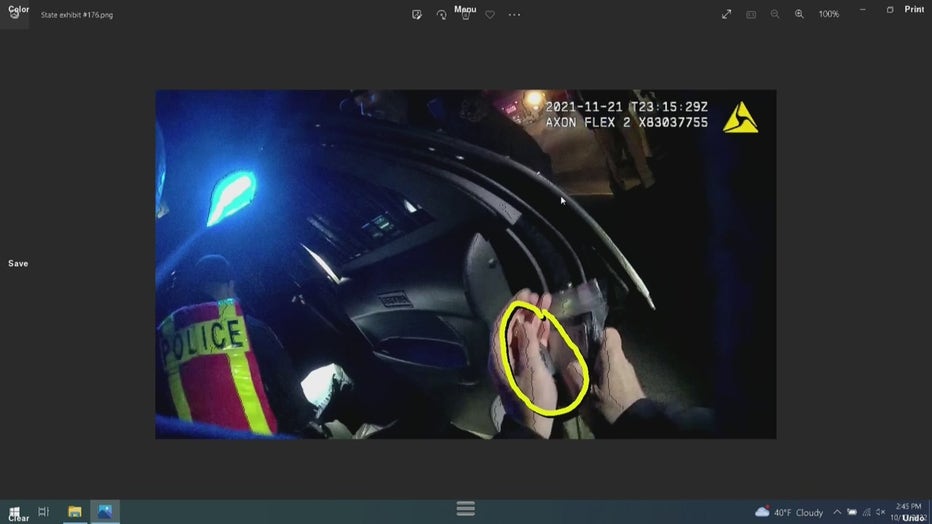
"Black Ford key" found in search of Darrell Brooks
Luling said he searched Brooks before he was placed into a squad. He said he found a "black Ford key."
Luling said Brooks questioned why he was being detained. He said he told Brooks he was being detained because he matched the description from an incident in the downtown area. He didn't mention the parade.
On cross, Brooks asked Luling whether Officer Moss said a witness indicated they saw multiple suspects exit the vehicle. Luling said two officers heard there may have been more than one suspect who ran from the vehicle.
"I recall there being a description of either a light-skinned Black male or possibly a Hispanic male wearing a white shirt, as well as the possibility of a white male with curly brown hair," said Luling.
Luling then described how he was ordered by Officer Moss to set up a perimeter.
Brooks asked if he recalled being advised that the male Black had possibly fled southbound, and the male white had possibly fled northbound. An objection from the state was sustained.
Brooks asked Luling what the person being detained was wearing. He stated a red T-shirt and blue jeans. Brooks asked if they were jogging pants. Luling confirmed they were blue jeans.
The defendant asked why the person was being detained.
"You were being detained for being involved in a crash in the downtown area," said Luling.
Brooks, reading from the report that Luling said he wrote, Brooks asked if he recalled stating, "I was confident that Brooks was either the driver or the passenger of the striking vehicle."
Luling said this was in his report but, "I didn’t say that. It was an internal dialogue with myself…"
Brooks asked if, at time of the report, he was confident there was more than one person in the vehicle. Luling said "no." Brooks asked why he wrote it in that fashion.
"I was confident that you were involved with that vehicle in the crash in the downtown area," said Luling.
Brooks asked why Luling referred to a passenger. Luling said initial reports claimed there may have been a passenger that fled from the vehicle.
Brooks asked Luling, "Where is the footage of you finding the key?" to the Ford SUV. Luling said he was not wearing a body camera when he responded on Elizabeth Street.
Luling was asked if he heard a horn, and Luling said "no." Brooks asked if there was any reason why he included in his report that there was a vehicle blaring its horn. An objection from the state was sustained.
Brooks then went into his usual questioning about whether the witness filed a claim in the matter, who subpoenaed him, if he knows anyone who filed a complaint and whether an entity is a "living, breathing human."
Scheduling discussion
After the afternoon break, there was a discussion about scheduling, and the state indicated at that time they were looking at resting Wednesday, potentially. Judge Dorow then informed Brooks that he would need to provide an order of witnesses so that they "have some idea of what your game plan is for them," also noting that Brooks deferred his opening statement.
Brooks said he was confused as to the lack of the same requirements for the state. Dorow noted that the state was helping Brooks in serving his subpoenas and arranging his witnesses. Brooks said he would be ready and have an idea of who he thinks should come in, but he wouldn't provide an order. Opper said they needed details from Brooks, or he could arrange his own witnesses. Dorow agreed, saying Brooks should cooperate with the state.
Brooks said he would not give a specific order of witnesses to the court. The judge asked if he would give them an order based on time of day and number of witnesses (i.e. two witnesses on Thursday afternoon, for example). Brooks said he just said that, and the judge said she was OK with that.
Draelon Leija, Waukesha police officer, drove Brooks to Muskego PD
Next up for the state was Waukesha Police Officer Draelon Leija, who transported Brooks to the Waukesha Police Department.
Leija identified Brooks as the man he transported to Muskego PD. He said he first met Brooks at Waukesha Memorial Hospital "in a police hold."
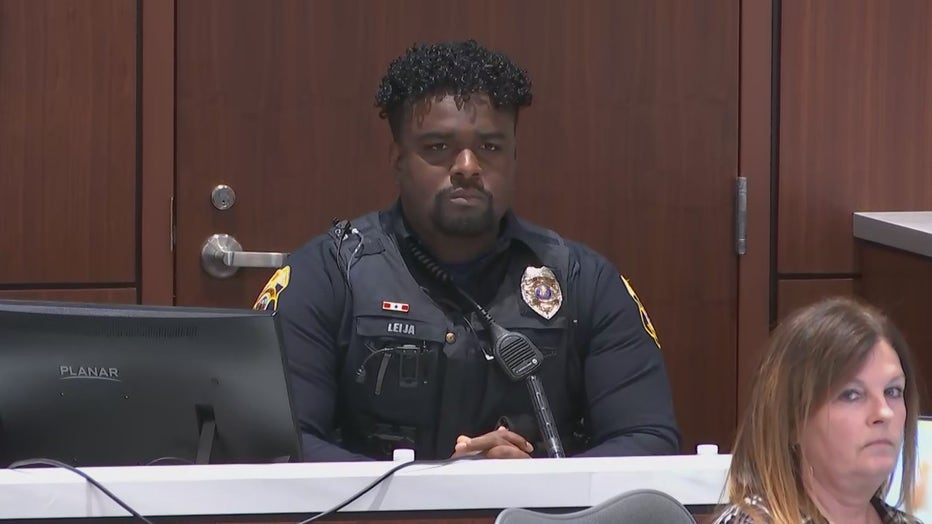
Draelon Leija
He said he was taking him to Muskego because Detective Carpenter would be there to question him at some time in the future. Leija was questioned about why he didn't take Brooks to Waukesha PD. He noted they had no holding cells, and Muskego was willing to hold Brooks on mutual aid.
As they drove, Leija said Brooks, noticing the police presence due to the parade response, said, "Damn, it looks like they’re dealing with something heavy."
Leija said he didn't say anything, and Brooks continued, asking if there was a basketball game going on that night. Leija replied that he wasn't sure.
At Muskego PD, Leija said he watched Brooks from 1 a.m. to 7 a.m.
"He slept most of the night, got up around 5 a.m., asked for water. I got him water, and he asked to make a phone call to his daughter," said Leija.
That phone call was not allowed.
He said Brooks also complained the room was too bright, and Leija said he turned off the lights for Brooks.
On cross, Brooks asked Leija about his checks on Brooks at the jail in Muskego, asking how Leija knew Brooks was sleeping. Leija said the cover was over his head, and he saw Brooks' chest rise and fall. He said Brooks could have been sleeping.
Brooks then asked Leija why the suspect was denied a phone call. Leija said he had to wait until a detective could "talk to you." Leija said he wasn't sure if that was standard practice or not "but just following instructions."
Brooks asked if he was given information on the suspect being questioned, and Leija said he could not recall.
The defendant also asked questions about the police hold room and the Muskego PD cell, specifically whether there were cameras.
Brooks also asked about the recording of the detainee during transport to Muskego, specifically if Leija noticed any strange movements or "anything that would alarm you."
"Nothing that would alarm me, no," said Leija.
Detective Jay Carpenter, Waukesha Police Department
Next up for the state was Waukesha Police Detective Jay Carpenter. He was in the parade, marching with the Honor Guard unit.
He said he went back to the police department after he finished in the parade. He came in contact with another officer who explained that a vehicle had driven through the parade route in downtown Waukesha, that there were approximately 30-40 down, that many were injured or deceased and that there was also an officer-involved shooting.
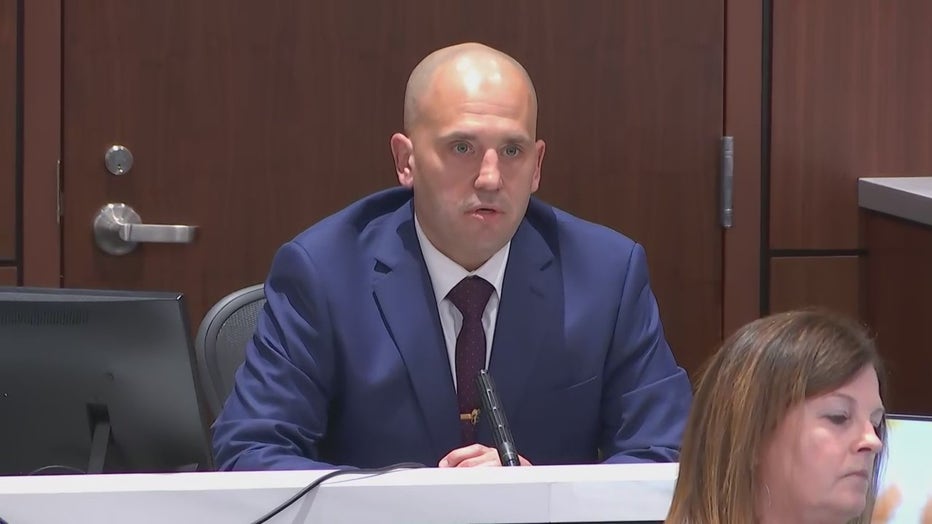
Jay Carpenter
He said it was chaotic and confusing when he went out, nothing like anything he’d ever experienced as far as radio traffic. He said the event evolved into two different forms as officers called for ambulances to tend to the wounded while dispatchers also learned someone was loitering around 500 Elizabeth that some believed may have been a suspect.
"The descriptions… were comparable, nearly identical to the descriptions I was hearing for the driver in the parade incident," said Carpenter.
He said he heard officers from a separate jurisdiction had come in contact with the suspect and that he was in custody, identified as Darrell Brooks.
"Information that I heard over police radio was an African American male, blue jeans and a red T-shirt," said Carpenter.
He said when he responded to the scene on Elizabeth Street, Brooks was already in custody and handcuffed. Carpenter said Brooks was placed in the rear of a Waukesha police car, taken into custody for loitering and suspected as the driver in the parade incident.
He was asked if he had any information about the vehicle used when coming in contact with the suspect.
"Yes, a red SUV that was actually a red Ford Escape," said Carpenter. "The vehicle was parked over on Maple Avenue, which is about 2.5-3 blocks west of Elizabeth Street where Mr. Brooks was located and taken into custody."
He said he spoke with Brooks at a substation on Les Paul Avenue. He identified the defendant as "Darrell Brooks."
Carpenter was asked in Brooks looked different in court than he did on Nov. 21, 2021.
"At the time of the incident, Mr. Brooks had longer hair, braided style hair that probably went halfway down his back," said Carpenter.
He said Brooks had a beard at the time that was longer.
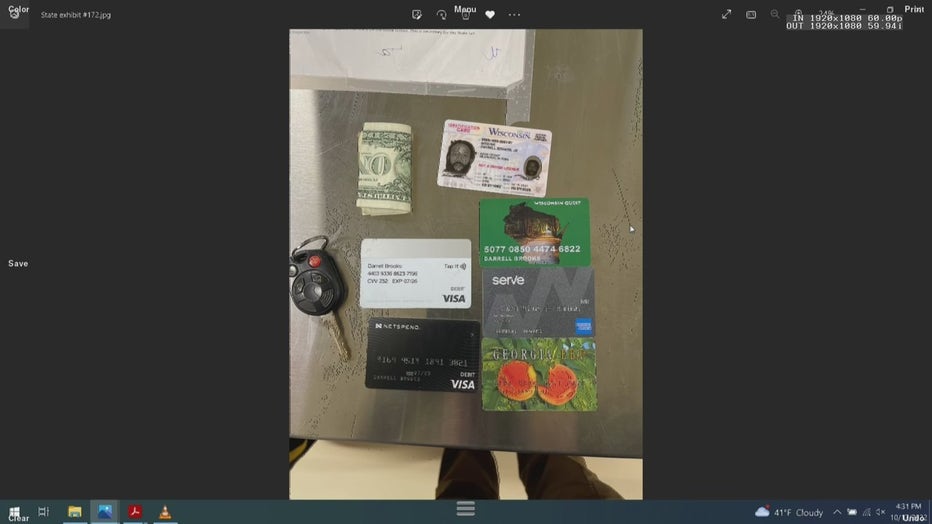
Items found on Darrell Brooks' person when he was arrested
He said he received items that were on Brooks' person at the time of his arrest, including an ID card with Darrell Brooks' name and photo on it, a Quest card with Brooks' name on it, along with credit cards with Brooks' name on them and an EBT card with Brooks' girlfriend's name on it. He added there was $4 in cash and a Ford key.
Carpenter was shown a still image from "the middle of the parade" and identified the driver of the red SUV as Darrell Brooks.
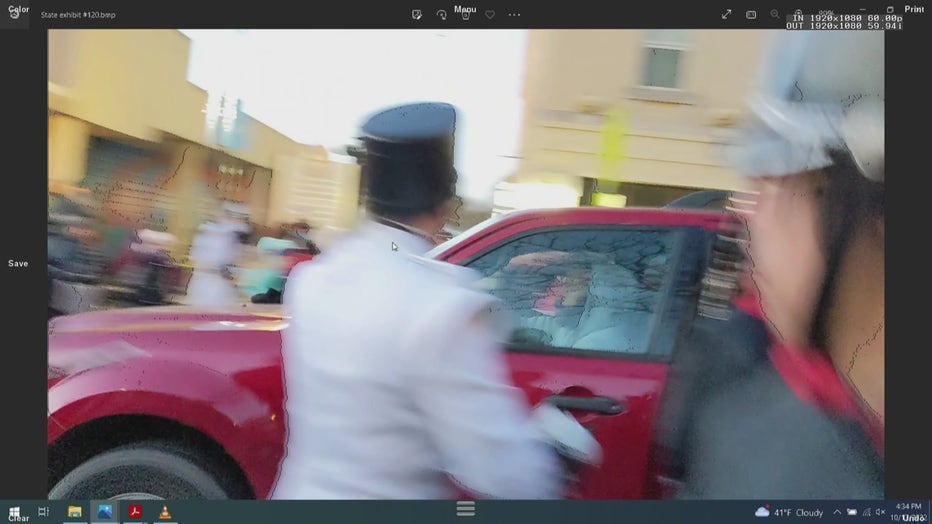
Other than collecting personal information from Brooks, Carpenter was asked what he was doing at the substation.
"Mainly, at that time, just waiting for further information as to what was going to be done next. The scene was very, very chaotic. I know there were so many victims out there, they didn’t even have enough ambulances to transport them all," said Carpenter. "It took, I feel like, probably hours to get it really under control."
Carpenter was asked if Brooks complained of any injuries. He said Brooks said there was an injury to his knee and right shoulder.
"Mr. Brooks told us his shoulder was injured when he was arrested. He indicated the arresting officers slammed him to the ground," said Carpenter.
He said he reviewed Rebecca Carpenter's body camera video of Brooks' arrest and saw "no" use of force.
"There was no force used at all," said Det. Carpenter. "Mr. Brooks was given verbal directions by officers to get down onto the ground, and he did so entirely on his own."
He said Brooks was taken to the hospital after complaining of the injuries. Carpenter noted injured parade victims at the same hospital, and said, "We escorted Mr. Brooks into a room, trying to keep him away from the victims."
"Due to the mass amount of casualties… it was very busy," said Carpenter. "Many of the victims were taken to alternate hospitals because Waukesha Memorial could not handle the number of patients that were coming in."
At the hospital, Carpenter said Brooks’ demeanor was very calm.
"Based on his body language, his tone of voice, his attitude, you’d have never known he’d done something, or he was in custody for doing something so serious…" said Carpenter.
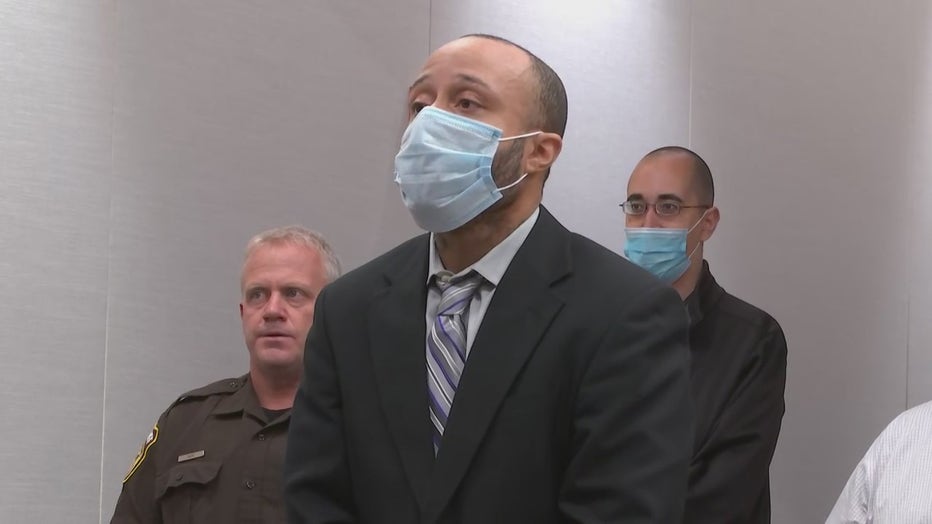
Darrell Brooks in court Monday, Oct. 17
He said at the time, he told Brooks he was in custody for a loitering investigation and possibly, disorderly conduct.
When asked why he didn't tell Brooks he was in custody for the parade incident, he said he wanted to make sure he "knew all the facts" and protected "the integrity of the case." He said at one point, they were looking for as many as four people, and they didn’t know how involved Brooks was.
He said Brooks continued to complain about shoulder pain, but his actions didn’t match that.
Mr. Brooks, when he would speak to me, he would move his arms about. He’d raise them up and down. He was talking about being in severe pain," said Carpenter, adding that "there was no 'favoring' that shoulder."
He said Brooks was checked out by the doctor and doesn't believe any medications were given. He was ultimately cleared and turned over to police custody.
Carpenter said he and Brooks had general conversations before Carpenter asked him why he was in the neighborhood where he was arrested. He said he did not record the conversation in the manner he would have if he were at the police department. There was a security camera at the hospital, but it had no audio. He said the audio was recorded on his phone. Carpenter said two FBI agents were with him.
"The FBI became involved in the investigation early on because we were not certain at that point whether this was a terrorist incident," said Carpenter.
He said when the FBI agents introduced themselves to Brooks, Brooks was "very surprised."
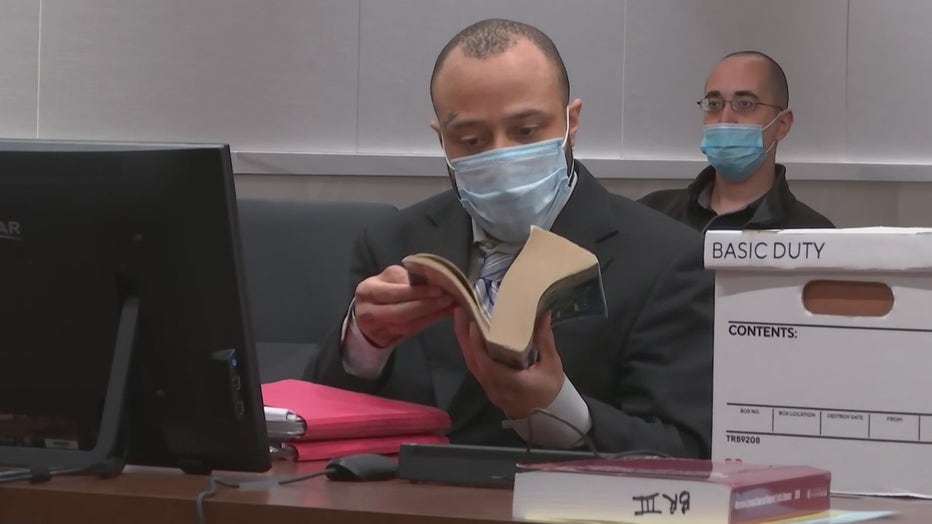
Darrell Brooks in court Monday, Oct. 17
"He said the word, ‘FBI’, in the form of a question," said Carpenter. "I could tell his tone was very surprised. He wasn’t as calm as he had been. He seemed concerned, uneasy. He questioned the agents further as to whether they were actually FBI agents. He had never actually seen an FBI agent before, so he was definitely surprised and uncomfortable."
Before playing a 10-minute clip from the 25-minute audio recording from Detective Carpenter's conversation with Brooks, Judge Dorow stopped questioning for the day shortly before 5 p.m.
Christmas parade attack
Prosecutors say Brooks drove a red SUV through the parade route on Nov. 21, 2021, killing six and injuring more than 60 others.
On Nov. 21, 2021, according to prosecutors, Brooks met up with his ex-girlfriend in Frame Park, the same woman he is accused of running over with his red SUV earlier in November 2021. She told police they argued in his SUV before he started driving, and he "was driving around with one hand and striking her in the face with his other hand." She eventually got out and called her friends for help.
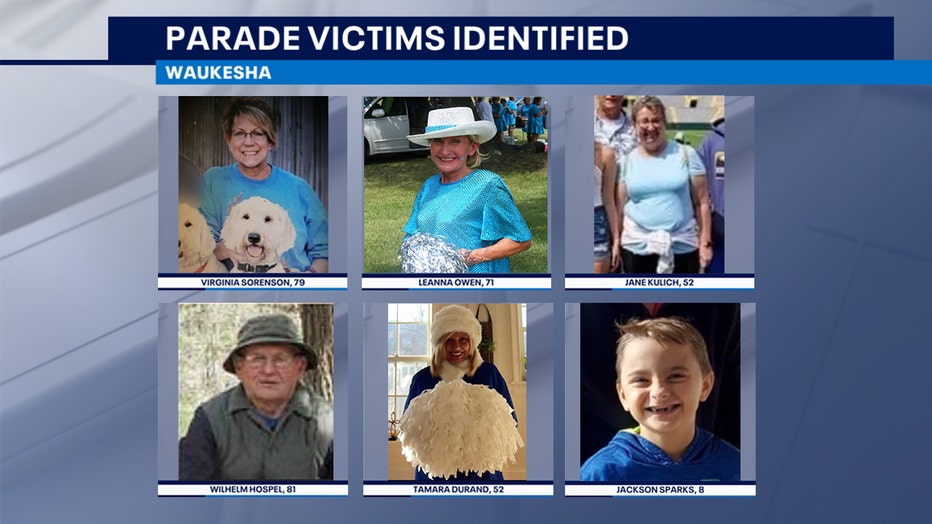
Waukesha parade attack victims identified
Soon after that, according to prosecutors, Brooks drove that red SUV through the parade route, killing Jackson Sparks, 8, Virginia Sorenson, 79, LeAnna Owen, 71, Tamara Durand, 52, Jane Kulich, 52 and Wilhelm Hospel, 81. More than 60 others were hurt.

